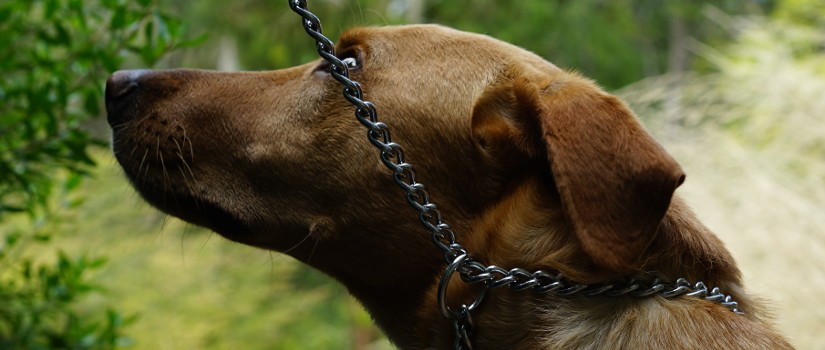While on a beautiful early morning dog walk the other day my relaxed mood suddenly evaporated when a man pushed his little dog. Although I only saw the event out of the corner of my eye, the result was plain to see. The dog recoiled from her human’s hand with ears flattened and tail tucked away under her belly. Unfortunately it didn’t seem to be a problem for her human who insisted his dog had an attitude and simply “didn’t like it” when he “told her off”. But it is a problem. What the little dog displayed was fear, nothing else, and it is something that is neither needed nor should it be wanted in modern dog training. The push might not have been hard and it is very possible the man did not intend to cause fear in his dog, at least not of the lasting kind. But the person’s motivation and the dog’s response are, sadly, very common.
Every push is one step closer to disaster
The push was a result of the dog jumping up at people – a very normal and understandable behaviour, especially in small dogs who find themselves far away from people’s faces. All the dog demonstrated was friendly greeting behaviour but what she eventually got in return – from the person she should trust the most – was physical assault. If repeated often enough with significant force or if done once with outright violence, pushing the dog away may indeed stop her from jumping up at people in the future but it’s usually not the only consequence. When the little dog responded with avoidance to her human’s outstretched hand shortly after the push, one problematic result was already visible. She had learned that bad things come from the hands of her human – a disaster in any human-canine relationship. This can easily generalize to create fear of all human hands, including those of a child who may innocently approach the dog one day and force the dog into self-defence mode. Not a good situation and entirely avoidable.
Yanking and pulling means loss of control
This past week I was also unlucky enough to witness several incidents of “yanking and pulling” by people walking their dogs. This manifests itself either in form of having constant pressure on the lead and frequently dragging the dog away from something or as intermittent violent jerking on the lead which sometimes can pull a dog off their feet. Either way, it’s bad. If the experience is unpleasant for the dog – which in most cases it would be – the dog is likely to develop negative associations with their handler and whatever else they happen to be aware of at that moment – another dog, a pedestrian, a cyclist, children playing, etc. Again, this is usually not what is intended. A person pulling on their dog’s lead is trying to gain control. They are trying to keep the dog away from others or want the dog to walk nicely by their side. But pulling and yanking are not methods of gaining effective and lasting control. The dog’s impulse to rush towards other dogs, people or interesting smells remains unchanged but is thwarted or suppressed by their humans forceful manhandling. The result is frustration and possibly aggression which can be directed at anything in the dog’s vicinity. And if the dog lunges towards other dogs because they already suffer from fear-aggression, adding more unpleasant experiences by yanking the dog will only increase their negative emotions and make things worse. Yanking on a dog’s lead is a crude and dangerous method. It shows a lack of understanding or – worse – a disregard of dog behaviour and animal learning principles and therefore a lack of control by the handler.
Forced socialisation risks “anti-socialisation”
No better than forcefully yanking a dog away from another dog or person is to drag a dog closer to these targets. This type of manhandling is generally with good intentions since the handler apparently hopes to improve their dog’s social skills. Sadly, the opposite is more likely to happen. Being forced to endure the proximity of something that makes the dog afraid or even just uncomfortable is bound to increase those emotions and can lead to aggression if the dog feels the need for self-defence. A variation of this type of “forced socialisation” is to pick the dog up and hold them close to other dogs or people. Imagine how a dog must feel being in this helpless position, their human’s hands firmly clasped around their body, feet off the ground and with no way of escaping. It is at the very least unpleasant but for sensitive or fearful dogs it can be a nightmare. The risk of “flooding” the dog with negative emotions and sensitize them even further is extremely high, yet the humans putting their dogs in these difficult situations see no problem with it.
The reason that manhandling dogs is still so common is due to the history of dog training, the focus on dominance, the misinterpretation of dog behaviour and the sometimes desperate desire of dog guardians to be in control. Often this need for control is reactive. Rather than planning ahead and teaching a dog necessary skills step-by-step and with modern, reward-based and force-free methods, many guardians respond to situations spontaneously and emotionally. They may get angry with their dog or be embarrassed when others witness their dog’s “bad” behaviour. But putting an untrained dog into situations they can’t handle is extremely unfair to the dog and puts unnecessary stress on dog and handler. It’s a recipe for disaster. The only way to get consistent and reliable “good” behaviour from your dog is by rewarding the dog for small steps towards the end goal and setting them up for success. This means putting your dog in a position where they are able and willing to pay attention to you – no distractions, no fear, rewards that are motivating for your dog – and gradually moving up in difficulty. This is no different to a person learning a complex skill. You don’t put a child in front of a piano for the first time and then smack them over the head if they are unable to play Beethoven. But that is exactly the level of “performance” that seems to be expected from dogs. Underlying these expectations is a tendency to interpret dog behaviour in human terms and as being rooted in “attitude”. If a dog behaves “badly”, it is easier to blame it on the dog’s character (stubborn, dominant, stupid, silly) than to accept one’s own fault of not considering or understanding what motivates dogs. Training a dog is work. Pushing and pulling them around is often easier.
Do your dog and yourself a favour and take “the long road” to train your dog. It may be faster than you think but most importantly you are far more likely to reach your goals. Be smart and learn from reward-based, force-free dog training professionals, be patient and have fun. It’s a high return investment and it carries zero risk.
RESOURCES
Reward Based Training by AVA (Australian Veterinary Association), PDF
The Use of Punishment for Behavior Modification in Animals by AVSAB (American Veterinary Society of Animal Behavior), PDF
 Copyright secured by Digiprove © 2016 Sylvie Martin
Copyright secured by Digiprove © 2016 Sylvie Martin 

I love this information. I will use this information when another dog joins our family. Unfortunately, my two Australian Cattle Dogs are not trained at all, except that they are so smart they trained themselves to blend in with our family habits. I have never known how to train a dog, i just know how to love them.
Brilliant article Sylvie – love your website! <3